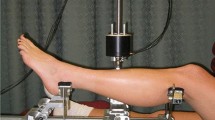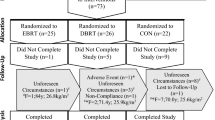Abstract
Bone mineral content (BMC) and bone mineral density (BMD) are common but imperfect surrogate measures of bone strength. The mechanical response tissue analyzer is a device that measures long bone bending stiffness (EI), which strongly predicts bone breaking strength. We hypothesized that isokinetic resistance training of the knee flexor and extensor muscles would increase tibial EI, BMC, and BMD in young women. Fifty-two women, aged 18–26 years, performed concentric (CON, n = 30) or eccentric (ECC, n = 22) isokinetic resistance training with the nondominant leg three times per week for 20 weeks. Before and after the training period, subjects were tested for CON and ECC peak torque of the knee flexor and extensor muscles with isokinetic dynamometry, tibial BMC and BMD using dual-energy X-ray absorptiometry, and tibial EI using mechanical response tissue analysis. Both training groups increased CON (15–21%) and ECC (17–31%) peak torque vs. the untrained leg. Tibial EI increased in the entire cohort (26%) and in each training group (CON 34%, ECC 16%) vs. the untrained tibia. Tibial BMC and BMD increased in the trained and untrained tibiae, with no significant differences between limbs. No differential tibial EI or bone mineral outcomes were observed between the CON and ECC training groups. In summary, CON and ECC isokinetic resistance training increased tibial EI, but not BMC or BMD, in young women.
Similar content being viewed by others
References
Wainwright SA, Marshall LM, Ensrud KE, Cauley JA, Black DM, Hillier TA, Hochberg MC, Vogt MT, Orwoll ES (2005) Hip fracture in women without osteoporosis. J Clin Endocrinol Metab 90:2787–2793
Marcus R, Wong M, Heath H 3rd, Stock JL (2002) Antiresorptive treatment of postmenopausal osteoporosis: comparison of study designs and outcomes in large clinical trials with fracture as an endpoint. Endocr Rev 23:16–37
Vestergaard P, Jorgensen NR, Schwarz P, Mosekilde L (2008) Effects of treatment with fluoride on bone mineral density and fracture risk—a meta-analysis. Osteoporos Int 19:257–268
Hernandez CJ, Keaveny TM (2006) A biomechanical perspective on bone quality. Bone 39:1173–1181
Roberts SG, Hutchinson TM, Arnaud SB, Kiratli BJ, Martin RB, Steele CR (1996) Noninvasive determination of bone mechanical properties using vibration response: a refined model and validation in vivo. J Biomech 29:91–98
Ammann P, Rizzoli R (2003) Bone strength and its determinants. Osteoporos Int 14(Suppl 3):S13–S18
Stüssi E, Bischof HJ, Lucchinetti E, Herzog R, Gerber H, Kramers I, Stalder H, Kriemler S, Casez JP, Jager P (1994) Development and adaptation of tensile strength by bones in the extremities in response to physical training exemplified by the tibia [in German]. Sportverletz Sportschaden 8:103–110
Miller LE, Wootten DF, Nickols-Richardson SM, Ramp WK, Steele CR, Cotton JR, Carneal JP, Herbert WG (2007) Isokinetic training increases ulnar bending stiffness and bone mineral in young women. Bone 41:685–689
Miller LE, Pierson LM, Nickols-Richardson SM, Wootten DF, Selmon SE, Ramp WK, Herbert WG (2006) Knee extensor and flexor torque development with concentric and eccentric isokinetic training. Res Q Exerc Sport 77:58–63
Thorne R (2000) Mechanical response tissue analysis: inter- and intra-trial reliability in assessing bending stiffness of the human tibia in college-aged women. In: Human nutrition, foods, and exercise. Virginia Polytechnic Institute and State University, Blacksburg
Nickols-Richardson SM, Miller LE, Wootten DF, Beiseigel JM, Zack MK, Ramp WK, Herbert WG (2005) Distal tibia areal bone mineral density: use in detecting low aBMD of the hip in young women. J Clin Densitom 8:74–79
Schafer JL (1999) NORM: multiple imputation of incomplete multivariate data under a normal model, version 2
Myburgh KH, Charette S, Zhou L, Steele CR, Arnaud S, Marcus R (1993) Influence of recreational activity and muscle strength on ulnar bending stiffness in men. Med Sci Sports Exerc 25:592–596
Liang MT, Arnaud SB, Steele CR, Hatch P, Moreno A (2005) Ulnar and tibial bending stiffness as an index of bone strength in synchronized swimmers and gymnasts. Eur J Appl Physiol 94:400–407
Steele CR, Zhou LJ, Guido D, Marcus R, Heinrichs WL, Cheema C (1988) Noninvasive determination of ulnar stiffness from mechanical response—in vivo comparison of stiffness and bone mineral content in humans. J Biomech Eng 110:87–96
Cleek TM, Whalen RT (2005) Effect of activity and age on long bones using a new densitometric technique. Med Sci Sports Exerc 37:1806–1813
Watts NB (2002) Bone quality: getting closer to a definition. J Bone Miner Res 17:1148–1150
Kontulainen S, Sievanen H, Kannus P, Pasanen M, Vuori I (2003) Effect of long-term impact-loading on mass, size, and estimated strength of humerus and radius of female racquet-sports players: a peripheral quantitative computed tomography study between young and old starters and controls. J Bone Miner Res 18:352–359
Heinonen A, Sievanen H, Kannus P, Oja P, Vuori I (2002) Site-specific skeletal response to long-term weight training seems to be attributable to principal loading modality: a pQCT study of female weightlifters. Calcif Tissue Int 70:469–474
Warden SJ, Hurst JA, Sanders MS, Turner CH, Burr DB, Li J (2005) Bone adaptation to a mechanical loading program significantly increases skeletal fatigue resistance. J Bone Miner Res 20:809–816
Robling AG, Hinant FM, Burr DB, Turner CH (2002) Improved bone structure and strength after long-term mechanical loading is greatest if loading is separated into short bouts. J Bone Miner Res 17:1545–1554
Robling AG, Hinant FM, Burr DB, Turner CH (2002) Shorter, more frequent mechanical loading sessions enhance bone mass. Med Sci Sports Exerc 34:196–202
Kelley GA, Kelley KS (2004) Efficacy of resistance exercise on lumbar spine and femoral neck bone mineral density in premenopausal women: a meta-analysis of individual patient data. J Womens Health (Larchmt) 13:293–300
Kelley GA, Kelley KS (2006) Exercise and bone mineral density at the femoral neck in postmenopausal women: a meta-analysis of controlled clinical trials with individual patient data. Am J Obstet Gynecol 194:760–767
Kelley GA, Kelley KS, Tran ZV (2002) Exercise and lumbar spine bone mineral density in postmenopausal women: a meta-analysis of individual patient data. J Gerontol A Biol Sci Med Sci 57:M599–M604
Martyn-St James M, Carroll S (2006) Progressive high-intensity resistance training and bone mineral density changes among premenopausal women: evidence of discordant site-specific skeletal effects. Sports Med 36:683–704
Burr DB, Turner CH, Naick P, Forwood MR, Ambrosius W, Hasan MS, Pidaparti R (1998) Does microdamage accumulation affect the mechanical properties of bone? J Biomech 31:337–345
Chatzipapas CN, Drosos GI, Kazakos KI, Tripsianis G, Iatrou C, Verettas DA (2008) Stress fractures in military men and bone quality related factors. Int J Sports Med 29:922–926
Franklyn M, Oakes B, Field B, Wells P, Morgan D (2008) Section modulus is the optimum geometric predictor for stress fractures and medial tibial stress syndrome in both male and female athletes. Am J Sports Med 36:1179–1189
Beck TJ, Ruff CB, Shaffer RA, Betsinger K, Trone DW, Brodine SK (2000) Stress fracture in military recruits: gender differences in muscle and bone susceptibility factors. Bone 27:437–444
Armstrong DW 3rd, Rue JP, Wilckens JH, Frassica FJ (2004) Stress fracture injury in young military men and women. Bone 35:806–816
Bennell K, Crossley K, Jayarajan J, Walton E, Warden S, Kiss ZS, Wrigley T (2004) Ground reaction forces and bone parameters in females with tibial stress fracture. Med Sci Sports Exerc 36:397–404
Kiratli JB, Steele CR, Arnaud S, Perkash I (2000) Spinal Cord Research Foundation final progress report: evaluation of bone stiffness following spinal cord injury. VA Palo Alto Health Care System
Acknowledgement
We thank J. M. Beiseigel and M. K. Zack for laboratory assistance. This study was funded by a grant from the U.S. Army Medical Research and Materiel Command (DAMD 17-00-1-0114).
Author information
Authors and Affiliations
Corresponding author
Rights and permissions
About this article
Cite this article
Miller, L.E., Nickols-Richardson, S.M., Wootten, D.F. et al. Isokinetic Resistance Training Increases Tibial Bending Stiffness in Young Women. Calcif Tissue Int 84, 446–452 (2009). https://doi.org/10.1007/s00223-009-9247-5
Received:
Accepted:
Published:
Issue Date:
DOI: https://doi.org/10.1007/s00223-009-9247-5




